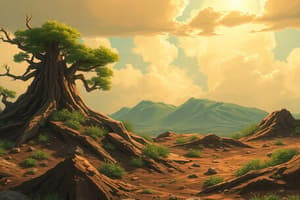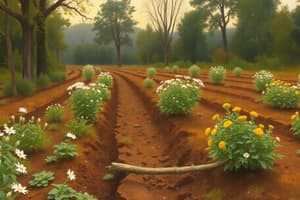Podcast
Questions and Answers
Soil is composed of mineral matter, air, water, soil microorganisms, and ______.
Soil is composed of mineral matter, air, water, soil microorganisms, and ______.
soil organic matter
The ideal proportions of soil include 25% air, 25% water, 5% SOM, and ______ mineral matter.
The ideal proportions of soil include 25% air, 25% water, 5% SOM, and ______ mineral matter.
45%
The three core properties of soil are texture, mineralogy, and ______.
The three core properties of soil are texture, mineralogy, and ______.
soil organic matter
Mechanical weathering breaks down rocks into smaller pieces without changing their ______.
Mechanical weathering breaks down rocks into smaller pieces without changing their ______.
The three soil separates, ranked from biggest to smallest, are sand, ______, and clay.
The three soil separates, ranked from biggest to smallest, are sand, ______, and clay.
_______ weathering changes the chemical composition of rocks and minerals.
_______ weathering changes the chemical composition of rocks and minerals.
Rocks are naturally occurring mixtures composed of two or more ______.
Rocks are naturally occurring mixtures composed of two or more ______.
Soil organic matter is abbreviated as ______.
Soil organic matter is abbreviated as ______.
The largest soil separate, in terms of particle size, is ______.
The largest soil separate, in terms of particle size, is ______.
The three core properties of soil are texture, ______, and soil organic matter.
The three core properties of soil are texture, ______, and soil organic matter.
Flashcards
Mechanical weathering
Mechanical weathering
The breakdown of rocks into smaller pieces without changing their chemical composition.
Biogeochemical weathering
Biogeochemical weathering
The change in chemical composition of rocks and minerals.
Clay
Clay
The smallest of the three soil separates.
Minerals
Minerals
Signup and view all the flashcards
Ideal soil composition
Ideal soil composition
Signup and view all the flashcards
Soil Separates
Soil Separates
Signup and view all the flashcards
Study Notes
Soil Science Study Notes
- Soil Components: Soil is composed of mineral matter, air, water, soil microorganisms, and soil organic matter. Ideal proportions are 25% air, 25% water, 5% soil organic matter (SOM), and 45% mineral matter.
- Soil Properties: Three core properties are texture, mineralogy, and soil organic matter.
- Rocks vs. Minerals: Minerals are solid crystalline materials, while rocks are naturally occurring mixtures of two or more minerals.
- Weathering: Mechanical weathering breaks down rocks into smaller pieces without changing their chemical composition, while biogeochemical weathering alters the chemical composition of rocks and minerals.
- Soil Separates: Sand (0.2-0.05 mm), silt (0.05-0.002 mm), and clay (<0.002 mm) are ranked by size, with sand being the largest and clay the smallest.
- Soil Texture: Soil texture refers to the proportion of sand, silt, and clay in a soil sample. This impacts the environment by affecting water holding capacity, decomposition rates, and permeability (how easily water and air move through the soil).
- Specific Surface Area: The specific surface area is the surface area available for a given mass of particles in the soil.
- Primary vs. Secondary Minerals: Primary minerals have experienced little or no change in composition. Secondary minerals are formed from the breakdown and weathering of primary minerals.
- Soil Structure: Soil structure refers to the arrangement of soil particles. Types include granular, blocky, prismatic, platy, and massive. A good soil structure enhances water infiltration, and root penetration, reducing erosion.
- Bulk Density: Bulk density is the mass per unit volume of dry soil.
- Soil Porosity: Soil porosity is the percentage of pores in a soil sample.
- Soil Compaction: Compacted soil has lower porosity but higher bulk density due to reduced pore space.
- Adhesive and Cohesive Forces: Adhesive forces involve attraction between unlike molecules, while cohesive forces involve attraction between like molecules. These forces are crucial in soil water movement.
- Soil Saturation: Saturation occurs when all available pore space is filled with water, leaving no air space.
- Field Capacity: Field capacity refers to the amount of water a soil can hold against the force of gravity.
- Permanent Wilting Point: Permanent wilting point occurs when a soil cannot absorb any additional water.
- Gravitational Flow: Water movement driven by gravity through larger soil pores is called gravitational flow.
- Capillary Flow: Water movement within smaller soil pores, influenced by adhesive and cohesive forces within and between water molecules and soil particles, is called capillary flow.
- Soil Texture & Water: Soil texture dictates the amount of pore space available, influence water storage and water flow through the soil.
- Soil Formation Factors: Soil formation is influenced by parent material, topography, time, organisms, and climate, with weathering of parent material as a significant process.
- Soil Horizons: A, B, and C horizons represent distinct layers within soil profiles based on characteristics such as texture, color, and composition. The differences reflect varying levels of soil material transformation and parent material influence.
- Soil Orders: Various classifications of soil types based on distinct characteristics including those found in Canada, such as Chernozems, Luvisols, Vertisols, and Cryosols, etc.
- Nutrient Uptake: Soil nutrients are absorbed via diffusion, Mass flow, and root interception.
- Liebig's Law of the Minimum: This principle highlights that crop growth depends on the most scarce nutrient and is not determined solely by the total amount of available resources.
- Nutrient Cycling: Nutrient cycling involves the movement of elements within and between the living and non-living components of an ecosystem, driven by photosynthesis and other biological processes..
- Soil Inputs, Transformations, and Losses: Understanding inputs, transformations (e.g., mineralization, immobilization), and losses (e.g., leaching, runoff) for different elements (N, P, K) in soil systems is key to managing soil health and fertility.
- Nitrogen Fixation: Conversion of atmospheric nitrogen to ammonia.
- Mineralization: Transformation of organic nitrogen forms to inorganic forms.
- Immobilization: Transformation of inorganic forms into organic forms.
- Denitrification: Conversion of nitrate to dinitrogen.
- P Fixation: Processes in soil that limit the availability of phosphorus.
- Fertilizers: Substances containing nutrients that enhance plant growth.
- Four R's: Right source, Right rate, Right time, Right place are strategies for effective nutrient management through fertilizers.
Soil Science - Trophic Interactions
- Trophic Levels: Groups of organisms in an ecosystem at the same level of a food web, with energy exchange between levels.
- Soil Organisms' Metabolism: Soil organisms utilize different metabolic strategies (e.g., autotrophs using CO2, heterotrophs using organic compounds) to obtain carbon & energy, influencing soil properties.
- Rhizosphere: The soil zone surrounding plant roots, significantly influencing soil microorganisms due to compounds and nutrient exudates from plant roots.
- Soil Diversity: Soil biological diversity encompasses the variety of species present and their functional roles.
- Biological Functions: Soil organisms play vital roles (e.g., decomposition, nutrient cycling) in soil ecosystems.
- Legume-Rhizobium Symbiosis: A symbiotic relationship between legumes and Rhizobium bacteria, enabling nitrogen fixation.
- Arbuscular Mycorrhizal-Plant Symbiosis: A symbiotic association with fungi enhancing plant nutrient uptake and other functions.
- Plant Growth Promoting Rhizo Organisms: Soil microorganisms that promote plant growth.
- Inoculants in Plant Production: Microbial inoculants are used to introduce beneficial microorganisms to soil for enhanced plant performance.
Soil Science - Essential Nutrients
- Macronutrients and Micronutrients: Plants require various nutrients, categorized as macro- (needed in larger amounts) and micro- (needed in smaller amounts).
- Essential Nutrients Criteria: A nutrient is deemed essential to plant life if its deficiency specifically impacts plant growth and functions cannot be substituted.
- Plant Nutrient Forms: Plants utilize distinct chemical forms for nitrogen (NO3− and NH4+), phosphorus (H2PO4−, HPO42−, and PO43−), and potassium (K+).
Studying That Suits You
Use AI to generate personalized quizzes and flashcards to suit your learning preferences.




